Imaro Series Tour Guide
 |
“Who am I? Who is my father? Where is my mother? Why do death and demons follow me wherever I go?” – Imaro in The Quest for Cush
Charles R. Saunders, the originator of Sword & Soul, passed away May this year (2020, Greg Mele covered a tribute for Black Gate). Saunders is most known for his Imaro tales chronicling an African-inspired “Conan the Barbarian” on the fictional continent of Nyumbani. Saunders also wrote of a heroine named Dossouye (separate series), amongst other characters. Over the years, Black Gate has reviewed the entire Imaro series and the book of associated stories called Nyumabi Tales (see list). The Goodreads Sword and Sorcery group honored his memory with a groupread, catalyzing this post. If you are looking for some buddies to share experiences while you read, then please join in (formally the Saunders group read goes through Dec., but discussions will continue beyond). This post serves as a tour guide for the series, clarifying transition from Book#1 to #2 per edition, provides Saunder’s own voice (excerpts) to capture the essence of Imaro’s Nyumbani, and reviews book availability.
Imaro Series Publication History:
The publication history also follows Imaro’s chronology as well. Links to Black Gate reviews included.
- Imaro: DAW 1981, Nightshade reprinted 2006 with story changes; Lulu 2014; 2008 Review by Howard Andrew Jones
- Imaro II: The Quest for Cush: DAW 1984, Nightshade reprinted 2006 with story changes 2008 Review by Ryan Harvey
- The Trail of Bohu: DAW 1985 & Lulu 2009 2009 Review by Bill Ward
- Naama War: Lulu 2010 2010 Review by Ryan Harvey, and 2009 coverage Howard Andrew Jones & John O’Neill
- Nyumbani Tales: Mvmedia, LLC 2018 2017 by Fletcher Vredenburgh
- The Warrior’s Way: unpublished collection mentioned in the 2017 introduction to Nyumbani Tales penned by Saunders (more on this below).
What is Sword & Soul?
Saunders’s revealed his motivation in the introduction of Milton Davis’s Griots: A Sword and Soul Anthology:
“Robert E. Howard and his contemporaries were products of their time. Racism, in the form of white supremacy, was an integral part of the popular culture of the early decades of the twentieth century, and as such it pervaded pulp fiction. As a product of a later time during which the tenets of racism came under vigorous challenge, my enjoyment of fiction from past decades was often compromised by the racial attitudes I encountered in my reading. On some occasions, I simply let it slide. On others, I wrestled with resentment. Then I discovered a way to resolve my dilemma.
Interest in African history and culture surged during the 1960s, and at the same time I was reading sword-and-sorcery and fantasy fiction, I was also absorbing heretofore-unknown information about a continent that was not “dark” as its detractors made it out to be. I realized that this non-stereotypical Africa of history and legend was just as valid a setting for fantasy stories as was the ancient and medieval Europe that served as the common default setting for everything from Conan to Lord of the Rings. A character came into my head then: Imaro, a black man who could stand alongside mythical warrior-heroes like Beowulf and Hercules, as well as fictional creations such as Conan and Kull.” – Charles Saunders
Imaro #1 Covers
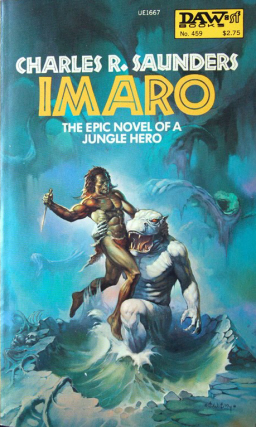 |
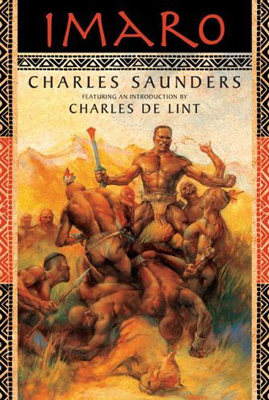 |
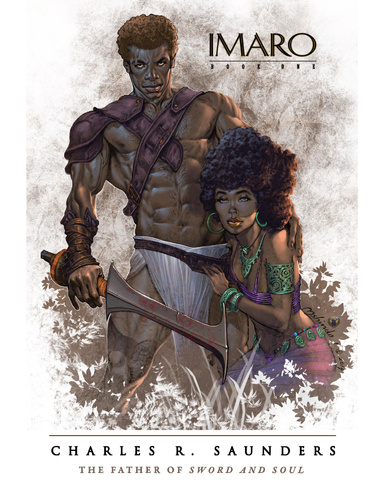 |
Imaro:
An excerpt captures Imaro’s presence best:
“The Ilyassai was a fearsome sight. His dark skin glistened sweat-slick through garments that hung in skimpy tatters from his massive frame. Crimson-crusted wounds scored his body like glyphs inscribed by devils. Dried blood matted his wooly hair. His face was hardened into an implacable mask of hatred. Unrequited vengeance flickered like a torch In his eyes, yet beneath the lamina of that emotion lay a core of grief so bitter it threatened to consume him entirely…” – Omaro #1
Imaro vs. Lovecraftian “Mashataan” Sorcery:
Each story compounds the conflict of Imaro versus the evil Mashatann and their demonic sorcery. Their aura has overtones of dark, Lovecraftian mythos, and their minions assume mythological status:
“Elephantine legs rose like wrinkled trees from the ground, Long bony arms hung like sticks from a pair of, knobby shoulders. The hands were incongruously delicate and graceful. Other than his head, those hands were the only remotely human features [spoiler’s name] had left…
…Upon the dais hunched a bizarre image sculpted from pitted, gray-green stone. From the waist up, the creature the sculpture depicted resembled Ngai the gorilla, although its skin was hairless and its wide mouth bore fangs even longer than those of the red panther Imaro had slain. It was the lower extremities of the unknown beast’s body that marked it as something alien to the world of natural beings. Its legs were the hindquarters of Mboa the buffalo: thick, muscular haunches tapering to sharp, lethal hooves.” – Imaro #1
“Against her will, Tanisha’s gaze left that single, sadly beautiful face and slid downward once again. And the gorge rose hot and sick from her stomach, blocking the cry of revulsion that leaped into her throat as she stared at the woman’s body. // Her long neck flowed smoothly into slender shoulders. Her bare breasts were small, cone-shaped, perfect. Beneath those breasts—horror! // A bulbous mass of tissue clothed in dark skin protruded from the woman’s abdomen. Its shape seemed a distorted replica of the buttocks of young child. Jutting from the asymmetrical mass were a pair of legs and a single arm ending in clenched, clawlike fingers…” – Imaro #2
Imaro #1 Contents
DAW |
NightShade |
| Prologue “I leave a warrior behind” | |
| 1: Turkhana Knives | Same #1 |
| 2: The Place of Stones | Same #2 |
| 3: Slaves Of The Giant Kings (Love interest and companion Tanisha introduced) |
3: The Afua (same basic story as “Slaves” with updated context) |
|
4: Horror in the Black Hills (Cover for DAW based on this one) |
Same #4 |
| 5 new content: Betrayal in Blood. | |
| 5: The City of Madness
(sage and companion Pomphis introduced) |
(moved to Book#2) |
Imaro #2 Covers
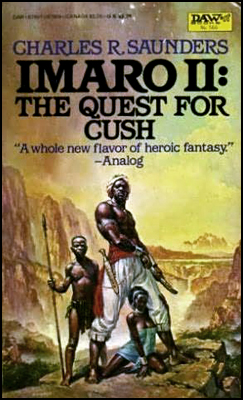 |
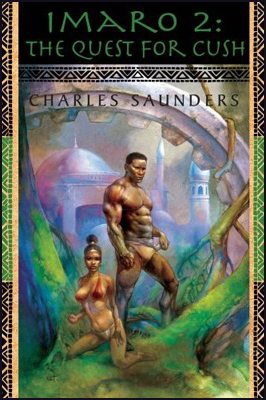 |
Imaro #2 Contents
DAW |
NightShade |
| Mji Ya Wzimuits (The City of Madness from Book #1 renamed and moved here) | |
| 1: In Mwenni | Same |
| 2: In Bana-Gui | Same |
| 3: On the Bahari Mashiriki | Same |
| 4: In Cush | Same |
A Fellowship Forms:
In the first volume, Imaro evolved from being a fatherless, abandoned child from the Ilyassai tribe… into a vengeful, tribeless Hercules-like figure set on destroying evil sorcery. We learned that his mother, Katisa had been force-married to a shaman named Chitendu. Chitendu was a servant to the Mashataan Demon Gods and was removed from power thanks to Katisa. She was also exiled for her being tainted. Imaro’s biological father is a mystery, who may have been someone other than Chitendu. Katisa is a fascinating figure who deserves more attention (in fact, she is featured in the first story in the Nyumbani Tales collection). What is clear, is that Imaro is very special, akin to the child of a god. His destiny is to confront the Mashataan gods/sorcery run through the Namaa.
Imaro may be the primary hero, but Saunders gifted him a fellowship with two others. First in the party was his love-interest, Tanisha, who grants companionship (she was rescued in Book#1). Secondly, is the pygmy sage called Pomphis, who is introduced either in DAW’s Imaro Book #1,last chapter “The City of Madness”, or in the introduction of the Nightshade 2006 edition (the same story renamed “Mji Ya Wzimu”). Depending on which edition of Imaro #1 and #2 you read, you may miss a key transition. Why move of the “City of Madness”? Well, the Nightshade edition of Imaro#2 captures the full story arc of Pomphis (a) finding Imaro and (b) delivering him to Cush.
Whereas Imaro #1 and #2 are coherent books evolved from separate short stories, Imaro #3 and #4 were written as novels from the start. DAW printed the first three versions. Actually, Saunders conceived of The Naama War during the DAW period, but the publisher opted to not release it (sticking to the all-fantasy-books-should-be-a-trilogy approach).
Imaro #3 Covers
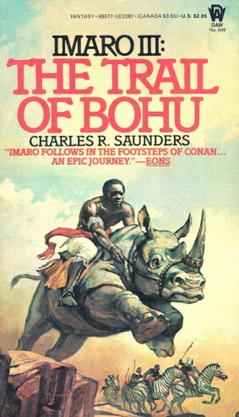 |
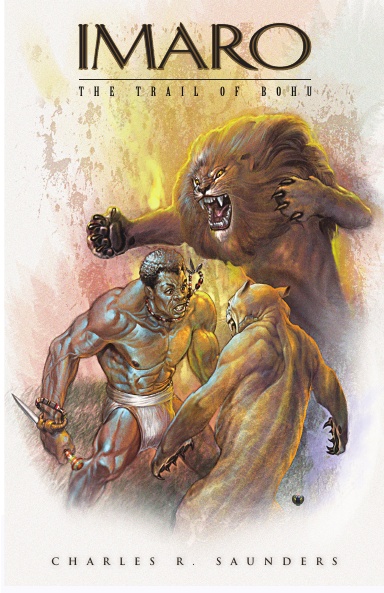 |
Availability & A Future Collection?:
Click here to go to Saunders’ website to locate books. Amazon and used bookstores carry several versions of these books. Lulu.com still distributes his books too (except for Book #2); note, the books appear under two different versions of his name:
- With the “R” … at Charles R Saunders Lulu: Imaro #1 and Imaro #3
- Without the “R” … at Charles Saunders Lulu: Imaro #4 and the two Dossouye novels
- “Mzee” (1984, Dragon Magazine)
- “The Skeleton Coast” (1978, Dark Fantasy)
- “Scorpion Sand” (1983, SPWAO Showcase)
- “Mai-Kulala” (1977, Space & Time; 1979 Swords Against Darkness IV)
- “Bwala li Mwesu” [The Pool of the Moon] (1976, Dark Fantasy)
- “Kibanda ya Kufa” [The Hut of Death] (1974, The Chronicler of Cross Plains)
- “Death in Jukun” (1979, Heroic Fantasy)
- “Death’s Friend” (1987, Weirdbook)
- “Drum Magic” (1989, Argonaut)
- “Amudu’s Bargain” (2018, The Might Warriors)
Imaro #4 Cover & Nyumbani Tales
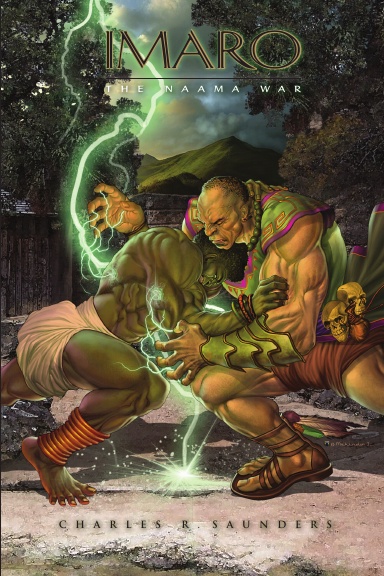 |
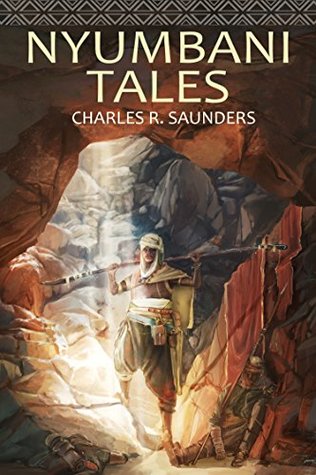 |
S.E. Lindberg resides near Cincinnati, Ohio working as a microscopist by day. Two decades of practicing chemistry, combined with a passion for the Sword & Sorcery genre, spurs him to write adventure fictionalizing the alchemical humors (under the banner Dyscrasia Fiction). With Perseid Press, he writes weird tales in the same vein (Heroika and Heroes in Hell series). He co-moderates the Sword & Sorcery group on Goodreads, and invites all to participate. He enjoys studying Aikido and creates all sorts of fine art in the family workshop. Touch base via Facebook.
I’ve seen references to a story called Imaro and the White Queen, but I’m unclear where and when it would have been published.
Patrick, I’d like to learn more about that too. Saw a reference on Wikipedia as a possible unpublished work called that. I wonder what the full table of contents for The Warrior’s Way would be.
The only other reference I can find to it is from an Angelfire website. According to that list, it was in something called Escape! #2. I’ve never heard of Escape! before, and can’t find anything related to what it may have been.
https://www.angelfire.com/tx3/robertehoward/saunders.html
Wow, the Angelfire.com listing is fantastic. Thanks for sharing.
BTW, I checked the Internet Speculative Fiction Database for Saunder’s bibliography and it recalled another Saunder’s story that is not collected yet, called “Amudu’s Bargain” appearing in Robert Price’s 2018 anthology “The Might Warriors.” I will add that to the above list.
But the listing didn’t have anything about the mysterious Escape! #2 / White Queen story.
http://www.isfdb.org/cgi-bin/ea.cgi?2590
I have only been able to find references to Escape! #1, where “The Blacksmith & the Bambuti” was originally published. No references to an Escape! #2 anywhere, so it seems likely that the issue was never published.
https://www.mycomicshop.com/search?TID=29208230
https://www.isfdb.org/cgi-bin/pl.cgi?391299
[…] And for a wonderfully informative and thorough look at the Imaro series that cuts through the confusion of its many multiple editions and uneven publishing history, please see S.E. Lindberg’s recent article at Black Gate: Imaro Series Tour Guide […]
Have listened to the first two installments on audiobook… Please. Anybody. Direct me to the rest of them in AUDIOBOOK format!!!
Where can I get imaro book 3 and 4 .free ebook
Even looking for paid ebooks may be an issue now. The links above worked when Charles Saunders was still alive, but now when I search the books do not seem available. Will have to ask around.
Thank you for this amazing list! I’ve been a huge fan of Saunders for a while now and have managed to track down all but 3 of the uncollected Imaro stories (Scorpion Sand, Drum Magic & The Skeleton Coast). If anyone can help me find physical or digital copies to read it’d be greatly appreciated! Thanks again for this great resource
In an interview republished in Polar Borealis magazine’s Sep/Oct 2020 issue, page 66, Saunders also talks about book 5, which was in the pipeline for publication in Sword and Soul Media. He mentions Book 5 in the Introduction to the Night Shade publication of Book 1, but this interview makes it seem like it was completed and ready to be released. So there could be a 5th book in addition to The Warrior’s Way.